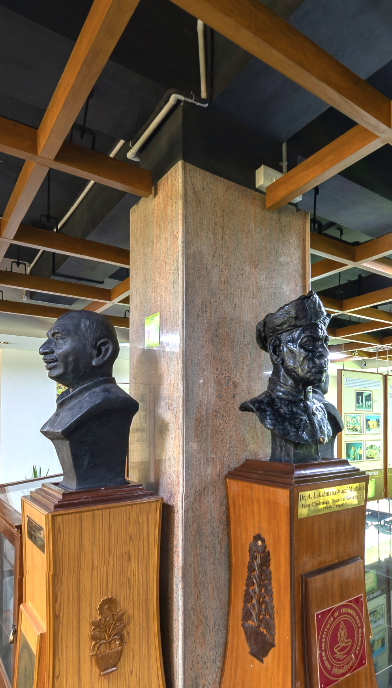Nuclear Quadrupole and Zero-field Nuclear Magnetic Resonance Spectrometer
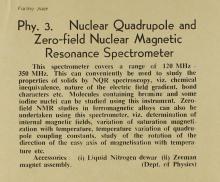
- Photographs , Equipment , 1970s
The image describes a nuclear quadrupole and zero-field nuclear magnetic resonance spectrometer that was photographed at the department of physics. The described spectrometer covers a range of 120cMHz-350 MHz and can be used to study the properties of solids by NQR spectroscopy, viz. chemical inequivalence, nature of the electric field gradient, bond characters etc. Molecules containing bromine and some iodine nuclei can be studied using this instrument.
Relaxation test frame
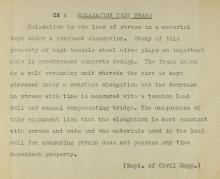
- Photographs , Equipment , 1970s
Relaxation is the loss of stress in a material kept under constant elongation. The image describes a self-straining unit developed by the Department of Civil Engineering, IIT Madras. A steel wire is kept stressed under a constant elongation and the decrease in stress with time, is measured with a tension load cell and manual compensating bridge. The uniqueness of this equipment lies in the constant elongation that is maintained with screws and nuts. The material used in the load cell for measuring strain does not possess any time dependent property.
Drug infusion pump
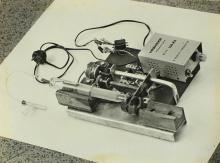
- Photographs , Equipment , 1970s
An infusion pump is a medical device that delivers fluids, such as nutrients and medications, into a patient’s body in controlled amounts. Infusion pumps are in widespread use in clinical settings such as hospitals, nursing homes, and in the home. The image shows a portable pump indigenously developed in December 1975 by the Biomedical Engineering Division at IIT Madras. The pump in the image has a constant flow rate of 5-10 cc/hr and is useful for the following: (a) Intravenous infusion of potent drugs to cardiac and renal patients, infusion of small quantities of nutrients to prematurely…
Rotary Drier
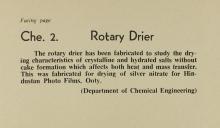
- Photographs , Equipment , 1970s
The image describes a rotary drier that was fabricated by Hindustan Photo Films, Ooty for the purpose of drying silver nitrate. The drier was photographed in the Department of Chemical Engineering at IIT Madras where it was used to study the drying characteristics of crystalline and hydrated salts without cake formation which affects both heat and mass transfer.
Air Heater
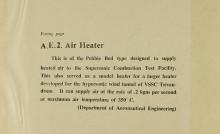
- Photographs , Equipment , 1970s
The Air heater described in the image is of the Pebble Bed type and was designed to supply heated air to the Supersonic Combustion Test Facility. It also served as a model heater for a larger heater developed for the hypersonic wind tunnel at the Vikram Sarabhai Space Centre (VSSC), Trivandrum. It can supply air at the rate of 0.2 kgm per second at maximum air temperature of 350° C. The equipment was photographed at the Department of Aeronautical Engineering, IIT Madras.
Laboratory test bed-cum-loading frame assembly for foundation model tests
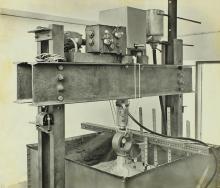
- Photographs , Equipment , 1970s
The foundation model tests are carried out using a versatile set-up for conducting tests on models of foundation elements, developed specially for the purpose of tests on shell footings. The image describes the set-up of this test that was done by the Department of Civil Engineering in IIT Madras. A funnel and hose assembly for pouring dry sand, mounted on the vertical post, can be raised or lowered at will, permitting consistent fall of sand. The sand bed is vibro –compacted in layers using a shutter vibrator moving on a plank. The falling weight penetrometer helps to check the uniformity of…
General purpose predictor-regulator
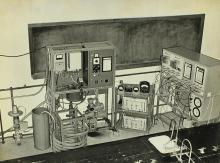
- Photographs , Equipment , 1970s
Seen in the image is a general purpose predictor-regulator that was photographed at the department of chemical engineering. The predictor-regulator is a dual loop control system consisting of a fast auxiliary loop and a main process loop. The control arrangement is such that it is considerably superior to conventional feedback controller. It also virtually retains all the benefits of free forward control and at the same time is free from its limitations.
Deep drawing and rubber pad forming set-ups
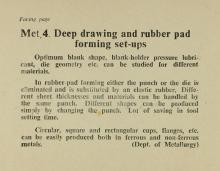
- Photographs , Equipment , 1970s
The image describes the process of rubber pad forming and its uses. Rubber pad forming is a metal working process where sheet metal is pressed between a die and a rubber block made of polyurethane. Under pressure, the rubber and sheet metal are driven into the die and conform to its shape, forming the part. Circular, square and rectangular cups, flanges etc. can be produced with both ferrous and non-ferrous metals. Deep drawing is a sheet metal forming process in which a sheet metal blank is radially drawn into a forming die by the mechanical action of a punch. Using the deep drawing and…
First Teleprocessing link in India
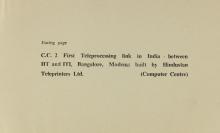
- Photographs , Equipment , 1970s
The photograph describes the first teleprocessing link in India that was between IIT Madras and ITI (Indian Telephone Industries) Limited, Bangalore. The photograph also mentions that the modems that were part of this teleprocessing link were built by Hindustan Teleprinters (HTL) Limited, Mumbai.
Burst Pressure Test on filament wound shell
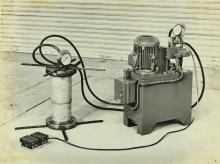
- Photographs , Equipment , 1970s
IIT Madras set up six centres in the year 1973. The Composite Structures (FRP) Research Centre, also known as the Fibre Reinforced Plastics (FRP) Centre, was one of them. The Centre was officially opened in March 1974 and it aimed at co-ordinating and utilising its expertise and resources to advance the special areas of technology that was of national importance. It also aimed at providing technical advice and leadership to the FRP industry in the country. The key objectives of the Centre and services offered included: Research and development of raw materials and composites, process design…
Explosive forming set-up
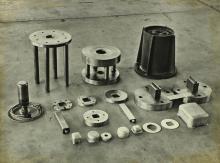
- Photographs , Equipment , 1970s
Seen in the image are components manufactured using the ‘explosive forming’ technique by the Department of Metallurgy at IIT Madras. Explosive forming is a technique used to form a metal plate using high shock pressure from an explosion. It is an ideal technique to use for producing large sized dome shaped components such as a boiler covers, rotor hubs, and dish ends etc. This method of production is economic as the volume of production is low. Welding of dissimilar metals, welding of heat exchange tubes with the end plates can also be done economically using this method.
Test sand for the measurement of crushing strength of granules
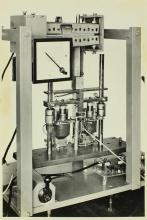
- Photographs , Equipment , 1970s
A sand test is carried out for rapid recording of crushing properties of granules. The data obtained is useful for carrying out fluid grinding operations in the chemical industry. The image describes a sand test that was set up by the Department of Mechanical Engineering for the measurement of crushing strength of granules. The image states that the features of the test were as follows: (a) A special design of load cells (proving ring type cells) in the ranges 0-2 kgs and 0-5 kgs (b) Freedom from errors of clamping the load cell and transverse loading due to irregular granule size (c) 3 phase…
General purpose predictor-regulator

- Photographs , Equipment , 1970s
The image describes a general purpose predictor-regulator that was photographed at the department of chemical engineering. The predictor-regulator is a dual loop control system consisting of a fast auxiliary loop and a main process loop. The control arrangement is such that it is considerably superior to conventional feedback controller. It also virtually retains all the benefits of free forward control and at the same time is free from its limitations.
Total Exhaust Flow Smoke Meter for continuous measurement of smoke intensity in the exhaust of diesel engines
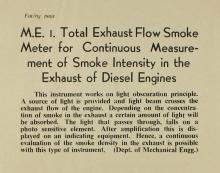
- Photographs , Equipment , 1970s
The total exhaust flow smoke meter is used for continuous measurement of smoke intensity in the exhaust of diesel engines. The image describes the functioning of the meter as the following: The instrument functions on the principle of light obstruction. A source of light is provided and a light beam crosses the exhaust flow of the engine. Depending on the concentration of smoke in the exhaust, a certain amount of light is absorbed. The light that passes through falls on a photo sensitive element. After amplification this is displayed on an indicating equipment. Hence, a continuous evaluation…
Electrolytic tax analogue of transistors to aid transistor design
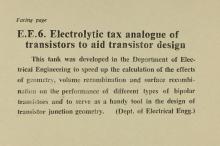
- Photographs , Equipment , 1970s
The image provides information on an electrolytic tax analogue of transistors that was developed in the Department of Electrical Engineering to aid transistor design. The set-up also aids in speeding up the calculation of the effects of geometry, volume recombination and surface recombination on the performance of different types of bipolar transistors and serves as a handy tool in the design of transistor junction geometry.
- Contribute
to the Centre -
Monetary
Support - Digital
Material

